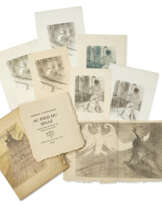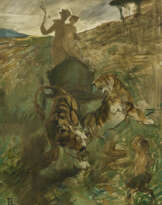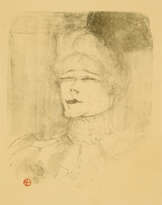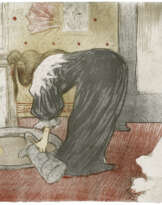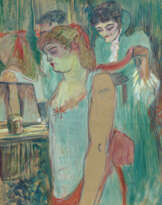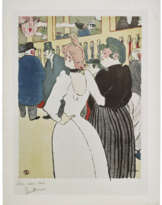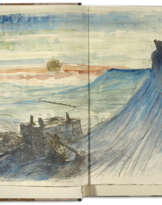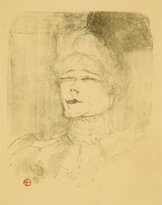ID 717795
Los 425 | HENRI DE TOULOUSE-LAUTREC (1864-1901)
Schätzwert
£ 400 000 – 600 000
Elles
The complete set of twelve lithographs, including the cover and frontispiece
Printed in 1896 by Auguste Clot, Paris
Published by Gustave Pellet, Paris, in an edition of one hundred
Signed 'TLautrec' in pencil by the artist on the inside of the cover (lower left)
Signed, dedicated and numbered 'A Monsieur Maus/ en souvenir/ Pellet/ 1er/ no 16' in ink by the publisher on the cover (lower right)
Variably numbered Serie no. 16, 18, 19 or 45 (as issued), with the publisher's paraph (Lugt 1194) and ink stamp (Lugt 1190)
Images & Sheets 20 1⁄2 x 15 3⁄4 ins. (52.1 x 40 cm.) (and similar)
Diana Metcalf Stainow (1926-2019) was born and raised in Boston and after her marriage to Gregory Stainow, who she met in New York, she moved to France, eventually splitting her time between Paris and London. She was a painter with an eye for color and pattern and a profound interest in non-western cultures. Her taste was grounded in her family's American cultural heritage. She was a descendant of Robert Treat Paine, one of the signers of the Declaration of Independence, and a founding member of the Pennsylvania Abolition Society. Her grandfather, Robert Treat Paine II, was a renowned Boston collector who gifted many masterpieces to the Boston Museum of Fine Arts. Her father, Thomas Metcalf, was one of the founders of the Boston Institute of Contemporary Art, formerly called the Boston Museum of Modern Art. During World War II, the Institute became the home of the Metcalf family, who occupied the two top floors of the building; the distinction between private and public space was blurred as local artists, members of the Institute, were welcome in the Metcalf household. During these formative artistic years for Diana – who attended the Boston Museum School – the Institute had an exhibition program striking for its diversity, inclusiveness and daring representation of the vitality of American art during the 1940’s, in addition to its contemporary European programming. This period was decisive in shaping her approach to collecting which ranged across centuries, cultures and styles. In the 40’s the Institute had a first solo show of Georges Rouault and exhibited works by Leger and Maillol – all artists in her collection that are now being sold. Stainow’s idiosyncratic approach was also evident in her elegant apartment in London. With her unique and daring eye, she commissioned a graffiti artist to paint the entrance foyer and hung Rouault tapestries and Toulouse-Lautrec's Elles prints over the graffiti to striking effect.
Provenance
Gustave Pellet (1859-1919), Paris (Lugt 1190).
Octave Maus (1856-1919), Paris; a gift from the above.
Presumably E. Mutiaux (1846-1925), Paris, acquired from the above.
Presumably Colonel Wilde, by descent from the above.
Maurice Loncle (1879-1966), Paris (Lugt 3489); his sale, Galerie Charpentier, Paris, 2 June 1959 (couverture, frontispice et 10 pl., for 5,500,000 Fr.).
Acquired at the above sale, and thence by descent to the present owners.
Literature
L. Delteil, Le Peintre-Graveur Illustré: Toulouse-Lautrec (Volume X), Paris, 1920, nos. 179-189 (another set illustrated).
J. Adhémar, Toulouse-Lautrec: His Complete Lithographs and Drypoints, London, 1965, nos. 200-210 (another set illustrated).
W. Wittrock, Toulouse-Lautrec: The Complete Prints, London, 1985, nos. 155-165 (another set illustrated).
R. Castleman & W. Wittrock, Henri de Toulouse-Lautrec, Images of the 1890s, exh. cat., Museum of Modern Art, New York, 1985, nos. 139-158 (another set illustrated).
G. Adriani, Toulouse-Lautrec: Das Gesamte Graphische Werk - Sammlung Gerstenberg, Cologne, 1986, nos. 171-181 (another set illustrated).
R. Thomson, “Images of the maisons closes” in Toulouse-Lautrec, exh. cat., Yale University, New Haven, 1991, nos. 141A-K (another set illustrated).
P. D. Cate, G. B. Murray & R. Thomson, Prints Abound, Paris in the 1890s, exh. cat., National Gallery of Art, Washington, 2001, nos. 51-55 (another set partially illustrated).
J. Döring, Toulouse-Lautrec und die Belle-Époque, exh. cat., Museum für Kunst und Gewerbe, Hamburg, 2002, pp. 186-195 (another set partially illustrated).
R. Thomson, P. D. Cate & M. W. Chapin, Toulouse-Lautrec and Montmartre, exh. cat., National Gallery of Art, Washington, & The Art Institute of Chicago, 2005, nos. 259a-l (another set illustrated).
F. Roos Rosa de Carvalho, Printmaking in Paris, The rage for prints at the fin de siècle, exh. cat., Van Gogh Museum, Amsterdam, 2012, pp. 102-105 (another set partially illustrated).
| Künstler: | Henri de Toulouse-Lautrec (1864 - 1901) |
|---|---|
| Angewandte Technik: | Lithografie |
| Material: | Acrylglas, Kunststoff |
| Kunst Stil: | Impressionismus |
| Herkunftsort: | Westeuropa, Frankreich, Europa |
| Künstler: | Henri de Toulouse-Lautrec (1864 - 1901) |
|---|---|
| Angewandte Technik: | Lithografie |
| Material: | Acrylglas, Kunststoff |
| Kunst Stil: | Impressionismus |
| Herkunftsort: | Westeuropa, Frankreich, Europa |
| Adresse der Versteigerung |
CHRISTIE'S 8 King Street, St. James's SW1Y 6QT London Vereinigtes Königreich | |
|---|---|---|
| Vorschau |
| |
| Telefon | +44 (0)20 7839 9060 | |
| Aufgeld | see on Website | |
| Nutzungsbedingungen | Nutzungsbedingungen |


